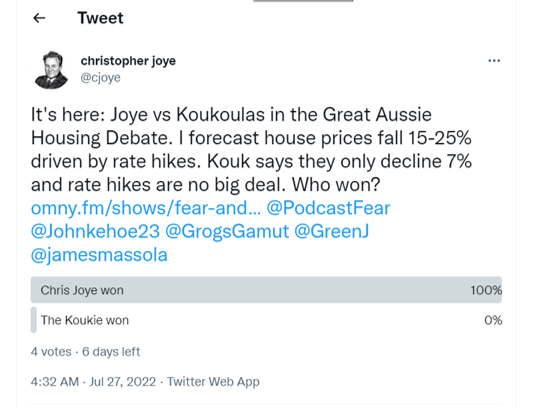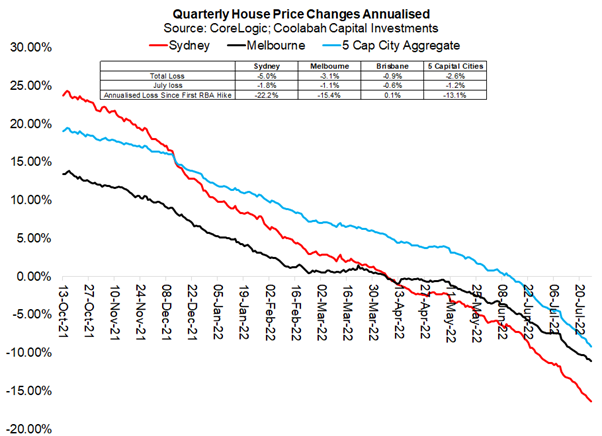Sydney house prices now falling at 22% annual pace; Melbourne prices declining at 15% per annum
Using the latest CoreLogic data to 26 July, we can reveal some new insights. First, Sydney's house price losses since their peak in February have now officially exceeded 5% for the first time. Melbourne's house price declines have also breached 3.1%. Nationally, across the five biggest capital cities, losses are 2.6% since the market peaked in May at almost exactly the same time the RBA launched its first interest rate hike.
Since it is clear the first RBA hike broke the Aussie housing market with a striking structural acceleration in house price declines (see grey shaded line in the chart below), I have added in a new line in the embedded table that displays the annual pace of house price losses since 4 May 2022 (ie, the day of the first RBA hike). Over this period, which is almost one quarter's worth of data, Sydney house prices have been falling at a stunning 22.2% annual rate. Melbourne is not far behind with annualised losses of 15.4%. Across the five biggest capital cities, dwelling values are shrinking at a 13.1% annual rate.
My second chart below shows the quarterly (or 3 monthly) annualised rate of house price growth across Sydney, Melbourne, and the 5 largest capital cities since October last year. What you can see is a very clear acceleration in the rate of Aussie house price falls: and there is no end yet in sight.
With the RBA set to hike at least another 50 basis points in August, it will have imposed an unprecedented 175 basis points of hikes on borrowers since the start of May (or effectively over the last 3 months). This will only further exacerbate what will doubtless be the greatest Aussie housing crash in history, which we first forecast back in October 2021.
Finally, check out the "Great Aussie Housing Debate" with economist Stephen Koukoulas, who argues that interest rate hikes are not a key driver of house price declines, and forecasts that Aussie house prices will only fall 7% peak-to-trough and then embark on a new boom. This was hosted over at the Fear & Greed podcast...
In the debate, I counter that changes in interest rate are the single biggest determinant of purchasing power in the short-term, and therefore exert a tremendous influence on house price movements month-to-month and year-to-year. I argue that the variables Koukie cites as more influential---population growth and new building approvals or supply---have relatively modest impacts on house price movements in the short-to-medium term. Population growth and new housing supply only change the stock of people and homes by circa 1% to 2% per annum. In contrast, a 100 basis point change in mortgage rates can immediately alter all home buyers' purchasing power by around 13%, which can then get capitalised into house prices.
My question to you is: who won the great Aussie housing debate? You can vote over at Twitter via the link here...



Our Intellectual Edge: Making Every Basis Point Count
Our edge is in “alpha” generation in liquid, high-grade credit in contrast to traditional fixed-income strategies that drive returns through adding more interest rate duration risk, credit default risk, and/or illiquidity risk (or “beta”). Click here to find out more about us and the products we have available.
1 topic

